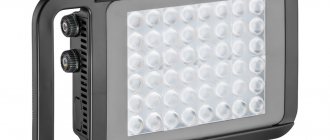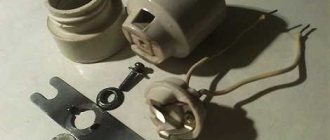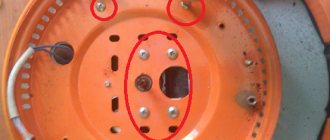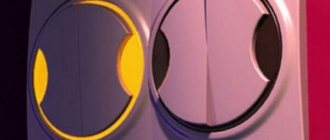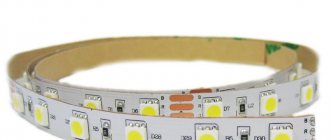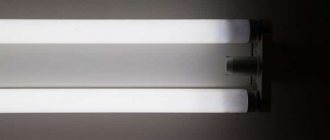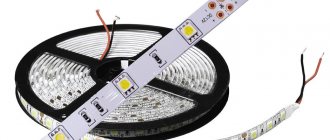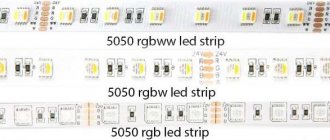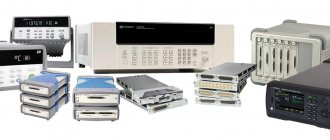When LEDs operate, heat is generated, which is dissipated by the tape substrate or additional base. If the LED strip heats up excessively during operation, overheating leads to a distortion of the color temperature and failure of the elements. If a problem is detected, it is necessary to modify the product or ensure reliable heat removal.
Additional sources of unpleasant phenomena
Have you managed to work through all the options outlined above, but still haven’t figured out why the LED strip is blinking? Perhaps the root of the trouble lies in the following aspects:
- Lack of power. In this combination of circumstances, blinking does not occur immediately, but only after heating the microcircuits and the electrons of the system elements.
- After soldering the ends, traces of flux and acid remained on the tape. In this case, the lighting defect is caused by the corrosive action of the acid.
- The battery in the remote control is exhausted.
- Incorrect installation. Flickering will make itself felt if you confuse zero and phase.
Advantages of a gentle temperature regime
Heating of LED lamps
The features of heat removal from LED lamps, which prevent its working parts from heating above 65-70 degrees, emphasize their advantages over other emitting products. The absence of mercury vapor harmful to apartment dwellers, as is observed in fluorescent devices, as well as a service life incomparable with other types of illuminants, make these lamps a real gift for the user.
The advantage of LED products is that despite internal heat losses, they still guarantee significant energy savings.
LED lamps perform best in well-ventilated areas with artificial (forced) ventilation. And installing such lamps in hot places with limited space, without free access and circulation of air masses, means exposing the products to danger.
Modern lighting devices, built on the basis of LED lamps, belong to the category of relatively new products that require constant monitoring and updating. As long as this process continues, each user has the opportunity to try out this original new product and experience it in various operating modes.
Checking the heating temperature of the LED lamp base
The light source is an LED; there can be one or many of them, depending on the desired power. Such LEDs in lamps are sometimes called chips.
Diffuser - serves to ensure that the light from the LEDs is diffused evenly and softly. Made from polycarbonate and other types of plastic.
A printed circuit board on which the LEDs are installed. It ensures efficient transfer of generated heat through thermal paste to the heat-removing metal (radiator).
The heatsink is the part of the lamp that is responsible for dissipating the heat generated by the LEDs. Often made of anodized aluminum, less often of regular aluminum. The radiator design has a ribbed shape to increase the heat transfer area.
Driver - required to convert AC to DC and rectify voltage ripples.
The polymer base of the plinth body serves to isolate the entire structure from electrical breakdown.
Base - serves to connect the conductive parts of the LED lamp with the socket.
The design and manufacturing process is described in detail in the video:
https://youtube.com/watch?v=MHezLYg-eMg
SP 52.13330.2011
The color of any physical body is determined by its spectral composition and the nature of the lighting that affects it. This means that when the same object is illuminated with LED lamps with different color temperatures, this object will have different shades. In order to set certain standards, SP 52.13330.2011 “Natural and artificial lighting” was developed.
SP 52.13330.2011 is an updated version of SNiP 23-05-95, valid in Russia until May 20, 2011.
SP 52.13330.2011 establishes standards for all types of lighting used in buildings and structures, in production and in open areas. Regarding the color of light, the document provides for the use of artificial sources, the color temperature of which should not go beyond 2400-6800°K.
In addition to a number of norms and rules, SP 52.13330.2011 provides recommendations for lighting of various types of premises. For example, in residential areas it is recommended to use yellowish-warm light temperatures that create a cozy atmosphere, and in work areas it is recommended to use cooler light temperatures that promote a working atmosphere.
How to identify a burnt-out block without instruments
How to understand that the power supply has failed and broken? How to quickly distinguish without measuring instruments that the breakdown is in it, and not in the tape itself?
If the entire LED backlight from start to finish works poorly or does not work at all (does not light), then this is the first reason for the failure of the unit.
But when the light is dim or part of the LED lighting has gone out, look for the problem in the failed LEDs. Most likely there was overheating or the contacts were unsoldered somewhere.
The second sign is a change in sound during operation. The faulty unit begins to squeak or whistle, although nothing like this has been observed before.
Moreover, the squeak may not be pronounced, which can be heard several meters away, but is quite audible up close.
The ice strip can still burn and glow as if nothing had happened. However, be aware that your power supply is reaching the end of its life.
If this device is under warranty and you did not buy it from a Chinese online store, then it’s time to send it for a replacement before the warranty period has expired.
The third sign of a burnt-out block failure is that the ENTIRE tape begins to blink or flicker like at a disco. Again - not in separate sections, but entirely and along the entire length.
Of course, there are several reasons for flickering, and you shouldn’t immediately blame just one unit for it.
Such blinking can often be seen not only on LED strips, but also on spotlights. But the main problem with these flickerings is the LED matrix and the burnout of its components.
Color temperature and human perception.
The choice of the correct color temperature of the sources determines how the surrounding space will emotionally influence a person and how the appearance of objects and their colors will be perceived. It is of great importance that different light sources are associated with a certain environment. For example, warm candlelight has a relaxing effect, white fluorescent lighting creates a working atmosphere, cool lighting creates greater contrast, and is used when work with high color discrimination is necessary.
There is a regulatory document that contains recommendations for selecting color temperature in rooms for various purposes: SNiP 23-05-95 “Natural and artificial lighting”. In it, in particular, warm light is recommended for residential premises, in rooms where visual work is performed - daylight 3000-4000K, in rooms with high requirements for color discrimination colder light up to 5000-6000K.
It also mentions that if there are a large number of green and blue objects in the illuminated space, sources with a color temperature of more than 4000K should be used, with a large number of red and yellow colors - no more than 3500K. Of course, when this regulatory document was created, the use of LED light sources was very limited, however, the information contained there can be useful when choosing them. For example, cold light lighting diodes contain a large proportion of the blue part of the spectrum, i.e. emphasize blue colors, and in warm white LEDs the blue component is suppressed by a large amount of yellow phosphor. In addition, you need to take into account the color rendering index of LED sources, because it is not always at its best, unlike halogen lamps, for example, but only in some more expensive models.
The materials provided by Philips Color Kinetics provide the following table (Table 3) for selecting color temperature depending on the desired atmosphere and application:
Why is the issue of thermal conditions so important?
Increased heating of the LED strip affects the performance of the product and light characteristics, and also negatively affects the parameters of the strip during the life cycle. During short-term overheating, reversible processes occur associated with a shift in color temperature or a decrease in light output.
The dependence of the brightness of the glow on temperature can be seen on elements of yellow and red colors; blue LEDs are the least sensitive to overheating. Tape manufacturers calibrate products on the RGB scale based on brightness and color measurements at a fixed temperature of 25°C. During testing, a short current pulse (25 ms) is applied, which does not affect the temperature background of the elements. During prolonged operation, the LED heats up, which reduces the brightness compared to the declared value.
Prolonged operation at elevated temperatures accelerates wear of the LED, which further reduces the brightness of the light. Laboratory tests have shown that an increase in operating temperature by 11°C leads to a reduction in the service life of the product by more than 2 times. There are LEDs designed for operation at elevated temperatures (up to 100°C). For example, products with white light have a service life of up to 50 thousand hours. But when the safety margin is developed, the brightness of the products drops by 70%.
LED strips by degree of protection
The popularity of LED strips is explained by their electrical safety, the ability to create artistic lighting effects, long service life, simple installation and versatility.
However, not every type of LED strip is suitable for use outdoors and in damp environments. This depends on the Ingress Protection Rating (IP) system, which corresponds to the international standard IEC 60529.
Hence, there are 2 types of LED strip production: open and protected (sealed).
In product labeling, the first number means protection from damage, the second from moisture.
Open
The LED strip consists of a printed circuit board, 8 to 20 mm wide, evenly spaced LEDs and resistors. In a standard product, the elements remain open and unprotected.
Open LED strip.
For interior design, where direct contact of water with the board is excluded, you can use tape marked IP20, that is, zero level of protection. It is acceptable to use such modules in outdoor advertising boxes that play the role of protection against moisture.
Protected
For finishing bathrooms, illuminating plumbing fixtures or installing them in the floor, a special type of LED strips is used - sealed (protected). A layer of transparent sealant is applied to them, and the degree of protection depends on its composition and thickness.
Protected LED strip.
For example:
- tapes marked IP66 or IP67 are suitable for bathroom design, flooring, stair steps, and installation on building facades;
- IP68 - tapes that are not afraid of direct and prolonged contact with water in a pool or sauna.
Of course, the cost of sealed LED strips is higher than products with a low protection class.
What happens if you connect like this?
The second tape will shine dimmer, and the last diodes will shine very dimly. If the tape is low-power (for example, SMD 3028, 60 diodes per meter), then the brightness of the glow along the entire length will be the same. But along the current-carrying paths, a current higher than the rated one will flow.
| Ready-made sets for ceiling lighting | |
| We will assemble the lighting personally for your ceiling. Qualitatively! We will deliver to your door in any city in Russia. |
The tracks will start to heat up, and heat is what LEDs fear most. As practice shows, such a connection scheme significantly reduces the service life of the LED strip. Therefore, a different (correct) connection scheme is used.
Connection diagram for LED strips from one power supply
This connection diagram uses one power supply. At the same time, its power must correspond to the total power of two (or more) tapes.
In order to supply 12 volt power to the second tape, you need to connect an extension wire to the output of the power supply. Connect the second end of the wire to the second tape. This way, the current will flow through the wire and not along the tracks of the first tape.
I recommend taking a larger cross-section of the extension wire so that there is less voltage loss. I use a 1.5mm section. The length of the wire is the same as that of the first tape, i.e. 5 meters. It is mounted in a niche, parallel to the first tape.
This LED strip connection scheme is used if it is possible to hide a powerful (and therefore large) power supply. If this is not possible, then another scheme is used. It's a little more complicated, but the cost is about the same
Connection diagram for LED strip with two power supplies
With this scheme, the extension wire is connected to a 220 volt network and extended to the power supply of the second tape. The wire cross-section is sufficiently 0.75 mm.
With this scheme, installation is a little more complicated (you need to secure and connect an additional power supply), but the power of the power supplies is 2 times less. Accordingly, their size is also smaller. Personally, I like this option better.
| Ready-made sets for ceiling lighting |
| We will assemble the lighting personally for your ceiling. Qualitatively! We will deliver to your door in any city in Russia. |
- Connection diagram for multicolor RGB LED strip
- How to choose an LED strip?
- How many years will an LED strip last?
- All articles >>
Which LED strip to choose for a sauna?
Advantages of installing LED strips in saunas
It is the correctly selected light composition that will create everything for comfort and relaxation. For a room such as a bathhouse or sauna
The best option would be to use heat-resistant LED strip with IP 65 and IP 68.
Interesting materials:
How does the Volma Layer differ from the formation? What is the difference between living and dead water? What is the difference between a Sherhebel plane and a jointer? What is the difference between solid and veneered doors? What is the difference between two and three way speakers? What is the difference between Floribundas and Shrubs? How do gas silicate blocks differ from foam concrete blocks? What is the difference between OSB and OSB boards? What is the difference between gray sewer pipes and orange ones? What is the difference between veneer doors and MDF?
LED strips and their heating
About 10 years have passed since the mass appearance of the first LED strips on chips such as SMD 3528 and SMD 5050. During this time, scientists managed to increase the luminous output of the crystal several times, while maintaining the miniature size of the LED. This is how highly efficient light-emitting diodes SMD 3014, SMD 2835, SMD 5730 and their derivatives appeared, which are today successfully used in the production of LED strips.
Below is the dissipation power of the most famous types of white SMD LEDs used in LED strips:
- SMD 3528 – up to 100 mW;
- SMD 5050 – 300 mW;
- SMD 3020 – 100 mW;
- SMD 3014 – 150 mW;
- SMD 2835 – 500 mW;
- SMD 5630 – 500 mW;
- SMD 5730-1 – 1000 mW.
It can be seen that the power of some LEDs has increased several times compared to the pioneer SMD 3528, which clearly proves the need for installation on a heat-conducting surface.
FAQ
Instead of a conclusion, we will answer frequently asked questions about the use and connection of LED strips. Let's start analyzing them!
8.1. What wire size should I use for the connection?
To calculate the cross-section of the wire for connecting an LED strip, you need to calculate its current or power. These data are indicated on its packaging, usually in the form of specific power per 1 meter (Ampere per meter or Watt per meter). If you bought an LED strip, and only the power is indicated, for example, 14.4 W/m, then simply divide the Watts by the supply voltage, let’s say it is 12 Volts.
14.4W/12V=1.2A
Then count the footage of the backlight connected to one line, and you will find out the total current consumption. Using the following table, select the current cross-section of the conductors.
In most cases, a 2x0.75 mm wire is suitable for connecting a single-color tape, and 4x0.75 mm wire is suitable for an RGB tape. It is inconvenient to use a smaller cross-section and the mechanical strength of thin conductors is always lower (they will break at the slightest load or damage). For high backlight power (more than 15 meters of tape) or a long distance from the power supply to the backlight, wires with conductors with a cross-section of 1.5 mm? are used.
Wire grades can be used like ShVVP or PVS. It is prohibited to use PUGNP due to its non-compliance with modern standards of insulation thickness, and popular cables of the VVGng-LS type are inconvenient to install and solder, because it has monolithic hard cores.
8.2. What is serial and parallel connection of tapes?
In the classical sense, a series connection is the connection of loads with one terminal to each other, or the connection of power sources according to the “plus one to the minus of the other” circuit. In the context of connecting an LED strip, serial means connecting the next piece of strip to the end of the previous one.
The total length of all segments should not exceed 5 meters, since the conductive tracks of the tape are not designed for heavy loads. This means that you can connect “in series” 5 pieces of 1 meter of tape, 10 pieces of 0.5 meters each, and so on, but no more than 5 meters in total.
8.3. How to connect an LED strip without a power supply?
Without a power supply, only a 220-volt tape works, but due to the disadvantages listed above, it is only suitable for a limited range of tasks.
A low-voltage strip without power supplies can be connected using batteries or an accumulator, for example, for lighting in a car or motorcycle. By the way, this is why 12V LED strip is more common than options with a 24V supply voltage, although controllers and dimmers support 24V and in this case you can connect backlighting with 2 times more power.
8.4. Is the tape connected on one side or on both sides?
Another controversial point: at how many points should power be supplied to the LED strip? On one or both sides? There are no restrictions - you can connect power from both sides. Moreover, cheap tapes may have a reduced cross-section of the conductive paths, because of this, towards the end of the tape there will be voltage drops and the LEDs will shine weaker. In this case, feeding the tape from both sides compensates for the drawdown.
But with “premium” or “luxury” class belts, you can safely supply power only from one side.
8.5. How to simply extend the wires from the tape without soldering?
The easiest way to extend wires is to use WAGO type terminals. They come in disposable and reusable lever clamp types. All you need to do is strip the wire and insert it into the terminal block connector, then tighten the clamp
But pay attention to the minimum cross-section of wires that can be connected to a specific terminal block, as well as how well it is clamped after connection
Do not twist the wires - they will not provide reliable contact.
How to choose LED lamps? Colorful temperature
Everyone “knows” that there are “warm” and “cold” light lamps. “Warm” is when the lamp shines yellow, and “cold” is when it shines blue. For a chandelier you need to take “warm”, and for a table lamp – “cold”.
It is clear that this “knowledge” is not enough to buy good LED lamps.
What do you need to know to buy the right LED bulbs?
First, let’s define what the “correct” LED lamp means. In our understanding, the right lamp is a lamp selected for a specific lamp. The choice depends on the purpose of the room, the type of lamp, and its location. Moreover, the choice of lamp even depends on the time at which the lamp will burn most often. I.e. The “right” lamp is just a lamp with the right characteristics.
Where to start choosing LED lamps?
We will not talk about external characteristics: base, shape and size of the bulb. They are selected based on the technical parameters of the lamp. Nothing complicated. There are less obvious parameters, but no less important. If you get them wrong, you can use the lamp. But how comfortable and cozy you will be in the light of this lamp is a difficult question.
Let's start simple
Reasons for heating the tape
If the installed tape overheats, the causes of the defect are:
- Errors made during installation or operation of the product. For example, poor-quality soldering increases the current, which leads to local heating of parts. To eliminate the malfunction, it is necessary to determine the problem area, and then use a soldering iron to ensure the required contact. In case of inaccurate installation, a short circuit of the LEDs may occur, leading to an increase in the load in the circuit.
- When using tape with increased power (more than 10 W per 1 linear meter of product), increased heat generation is the norm. When installing such products, it is necessary to use a gasket that promotes heat removal and dissipation.
- Low quality products get very hot due to excessive power consumption, which allows for high brightness when using cheap LED elements. Such designs quickly fail, since LEDs do not have a safety margin. Additional load is also applied to the power supply, reducing the service life of the device.
- Wrong choice of LED element type. For example, tapes coated with silicone material are not recommended for use in areas with low humidity. The additional protective layer impairs heat dissipation, which leads to overheating of the elements.
- Using twisted wires instead of soldering leads to poor contact and increased heating. When installing LEDs, the cables must be connected using lead-tin solder or special metal tubes that are crimped with pliers.
Special types of LED strips
In addition to colored and single-color, there are special types of LED strips that create special lighting effects or have additional properties:
- "running fire";
- side glow tapes;
- DIP-LED waterproof;
- White-TRIX with three glow colors;
- White-D-MIX with color temperature change;
- White-MIX with cold and warm glow diodes;
- RGB+White with white monochrome diodes and RGB diodes.
Each of these types of tapes has its own characteristics and areas of application.
Tapes "Running Fire"
An interesting variety where each diode changes the color and brightness of the light at will, independently of the others.
Using a controller that sends signals to addressable microcircuits, the effects of flickering lights, iridescent colors, and lights running in different directions are created.
Thanks to these properties, “running fire” LED strips are popular in nightclubs, restaurants and any premises where festive events are held.
Side glow tapes
Unlike the standard tape, where the chips are located on a flat part, in the side-glow tape they are attached to the ends. In this case, the LEDs themselves have a cylindrical shape, and the light falls along the illuminated plane.
They are indispensable in various advertising structures, as well as as backlighting for screens and monitors.
Side glow LED strip.
LED strip DIP-LED
This is one of the varieties of side-glow tape with 5 mm cylindrical LEDs.
DIP-LED tape is waterproof, coated with a thin layer of silicone, which allows it to be used on signs, boxes, dimensional letters and other types of outdoor advertising. The board is fixed using sealant or fasteners.
LED strip DIP-LED.
LED strip White-TRIX
Under this abbreviation a standard tape on a white board is produced. But as the name implies, instead of one type of LEDs, it uses three:
- cold white (7000K);
- daylight (4000K);
- warm white (3000K).
All three channels are connected separately and regulated by any RGB controller or specialized device.
LED strip White-TRIX.
LED strip White-MIX
This board alternates cold and warm emission diodes, creating smooth transitions and expressive lighting effects.
White-MIX tapes are loved by interior designers, as well as creators of advertising media. The back side of the board is covered with a 3M adhesive layer, so gluing it is quick and easy.
LED strip White-MIX.
LED strip White-D-MIX
This is an improved version of two-channel tapes with variable thermal temperature. This type of LED strips integrates 2-in-1 technological chips DUAL smd 3528, where 2 different types of phosphors are combined.
This modernization made it possible to achieve the most uniform mixing of tones without color spots characteristic of the previous version.
Thanks to the creation of perfectly even lighting, the White-D-MIX LED strip has found application in the design of luxury interiors.
Color temperature is regulated by controllers for conventional two-channel tapes MIX, CDW. The range includes boards of 60 and 120 LEDs per 1 linear meter.
LED strip White-D-MIX.
Reasons for LED strip heating
In order to understand why the LED strip heats up, you need to consider its operating conditions, connection method and other influencing factors. First of all, it is necessary to study the passport data and find out the operating temperature of the product. There are LEDs that heat up to 100°C or more during operation, this is normal and is a design feature. However, such elements are rarely installed on LED strips. As a rule, they are designed for operation in difficult conditions, when excess heat is dissipated into the cold surrounding space. There are other factors that need to be discussed specifically.
Quality
The number of LED strips on the market is huge. New manufacturers are constantly appearing, and industrial giants are not lagging behind. The more famous and popular the brand, the more fakes there are from Southeast Asian countries. They do not meet the stated parameters in almost all respects, and the main consequence of this is excessive heating. You can avoid such mistakes if, when purchasing, do not hesitate to ask the seller for the necessary certificates.
Overload
Many users purchase inexpensive products from unknown manufacturers. Such products rarely correspond to the parameters stated on the packaging. In particular, most of these tapes have excessively high power. This is done in order to use fewer LED elements and achieve the same brightness as normal products. When power is applied, the LEDs begin to receive too high a voltage, resulting in excessive heating. Simply put, excess voltage turns into heat. The solution to the problem will be either installing additional elements or using a step-down resistor.
Other
The LED strip often gets hot for other reasons:
- Sometimes the cause of overheating is the use of sealed LED strips with IP67 protection in warm residential areas. The elements are located inside a silicone tube, which does not allow excess heat to escape outside. A thermos effect occurs, the LEDs heat up and begin to rapidly degrade.
- Often the cause of excessive heating is too tight installation. The tape is attached so that a large number of elements are concentrated in one place - they are wound on a pipe, strips are laid, etc. Heat removal in such conditions becomes difficult, and the tape begins to overheat.
- Not only the tape, but also the power supply (driver) overheats. This occurs in the absence of some reserve power of the source. Over time, its characteristics decrease, it begins to work with overload and gets very hot. The solution to the problem is to replace the driver with a more powerful device.
How hot can an LED strip get?
The design of LED devices is fundamentally different from the design of traditional light sources. The efficiency of a modern LED is significantly higher than that of all alternative options and reaches 60%. This means that at least 40% of the energy consumed goes into heat generation. Therefore, any LED element heats up, and its operating temperature is determined by power, size and other factors.
The maximum temperature for most LEDs is 60°. If the tape heats up to 70°, the situation is considered critical and requires immediate intervention. When it comes to low-power elements, the heating is somewhat less, but the limit value remains the same. For protection, a cooling system, radiators or heat-dissipating substrate is used.
The normal temperature of a working LED strip is 40-45°. It feels like a slightly warm surface to the touch. This thermal regime is ensured by two factors:
- the number and conditions of LED illumination are calculated, the elements operate in optimal mode;
- The base of the LED strip is an effective radiator and absorbs most of the released thermal energy.
If the tape gets hotter and seems hot, you should unplug it and determine why this is happening. It is necessary to resolve the issue as quickly as possible, since even short-term overheating negatively affects the service life of the product.
Reasons for LED strip heating
In order to understand why the LED strip heats up, you need to consider its operating conditions, connection method and other influencing factors. First of all, it is necessary to study the passport data and find out the operating temperature of the product. There are LEDs that heat up to 100°C or more during operation, this is normal and is a design feature. However, such elements are rarely installed on LED strips. As a rule, they are designed for operation in difficult conditions, when excess heat is dissipated into the cold surrounding space. There are other factors that need to be discussed specifically.
Quality
The number of LED strips on the market is huge. New manufacturers are constantly appearing, and industrial giants are not lagging behind. The more famous and popular the brand, the more fakes there are from Southeast Asian countries. They do not meet the stated parameters in almost all respects, and the main consequence of this is excessive heating. You can avoid such mistakes if, when purchasing, do not hesitate to ask the seller for the necessary certificates.
Overload
Many users purchase inexpensive products from unknown manufacturers. Such products rarely correspond to the parameters stated on the packaging. In particular, most of these tapes have excessively high power. This is done in order to use fewer LED elements and achieve the same brightness as normal products. When power is applied, the LEDs begin to receive too high a voltage, resulting in excessive heating. Simply put, excess voltage turns into heat. The solution to the problem will be either installing additional elements or using a step-down resistor.
Other
The LED strip often gets hot for other reasons:
- Sometimes the cause of overheating is the use of sealed LED strips with IP67 protection in warm residential areas. The elements are located inside a silicone tube, which does not allow excess heat to escape outside. A thermos effect occurs, the LEDs heat up and begin to rapidly degrade.
- Often the cause of excessive heating is too tight installation. The tape is attached so that a large number of elements are concentrated in one place - they are wound on a pipe, strips are laid, etc. Heat removal in such conditions becomes difficult, and the tape begins to overheat.
- Not only the tape, but also the power supply (driver) overheats. This occurs in the absence of some reserve power of the source. Over time, its characteristics decrease, it begins to work with overload and gets very hot. The solution to the problem is to replace the driver with a more powerful device.
Advice for future buyers
Power dissipation is not the only factor that determines how hot the LED strip gets during operation. Equally important is the working space of the crystal, namely the degree of protection from moisture, the number of LEDs per meter and the ambient temperature.
LED strips with a high degree of protection from moisture and dust (IP65 and higher) should not be used in places where this is not necessary. For example, installing a waterproof section in the kitchen, which could accidentally be splashed with water, is not justified. The increased ambient temperature and the protective silicone shell greatly impede the removal of heat from the LEDs, which leads to a premature loss of their brightness. It is much more effective to use a LED strip with IP33 protection, mounted inside an aluminum profile with a diffuser.
Tape with IP65 or higher should be used in open outdoor environments with high convection. For example, tuning the underbody of a car, external advertising.
With medium and high installation densities (60–120 pcs/m), the heat generated by the LED spreads to adjacent elements. Ideally, the temperature of a tape that is turned on and warmed up for half an hour (regardless of the type) should not exceed 45°C, that is, it should be warm. If it gets hotter, then it definitely needs to be installed on an aluminum profile.
Attempts to prevent overheating of SMD chips led to the invention of LED strips and modules, which are a symbiosis of an LED strip and a radiator. Although they are not flexible, they can replace tape in many situations.
In conclusion, I would like to remind you of one more factor that can cause overheating. This is a low quality product. Some manufacturers deliberately overestimate the power consumption of SMD LEDs in order to clearly demonstrate the high brightness of their products. As a result of this trick, the LEDs in the strip quickly overheat, which is reflected in a sharp decrease in light output. And in this case, there is only one way out - the backlight will have to be redone.
Reasons for LED strip heating
In order to understand why the LED strip heats up, you need to consider its operating conditions, connection method and other influencing factors. First of all, it is necessary to study the passport data and find out the operating temperature of the product. There are LEDs that heat up to 100°C or more during operation, this is normal and is a design feature. However, such elements are rarely installed on LED strips. As a rule, they are designed for operation in difficult conditions, when excess heat is dissipated into the cold surrounding space. There are other factors that need to be discussed specifically.
Quality
The number of LED strips on the market is huge. New manufacturers are constantly appearing, and industrial giants are not lagging behind. The more famous and popular the brand, the more fakes there are from Southeast Asian countries. They do not meet the stated parameters in almost all respects, and the main consequence of this is excessive heating. You can avoid such mistakes if, when purchasing, do not hesitate to ask the seller for the necessary certificates.
Overload
Many users purchase inexpensive products from unknown manufacturers. Such products rarely correspond to the parameters stated on the packaging. In particular, most of these tapes have excessively high power. This is done in order to use fewer LED elements and achieve the same brightness as normal products. When power is applied, the LEDs begin to receive too high a voltage, resulting in excessive heating. Simply put, excess voltage turns into heat. The solution to the problem will be either installing additional elements or using a step-down resistor.
Other
The LED strip often gets hot for other reasons:
- Sometimes the cause of overheating is the use of sealed LED strips with IP67 protection in warm residential areas. The elements are located inside a silicone tube, which does not allow excess heat to escape outside. A thermos effect occurs, the LEDs heat up and begin to rapidly degrade.
- Often the cause of excessive heating is too tight installation. The tape is attached so that a large number of elements are concentrated in one place - they are wound on a pipe, strips are laid, etc. Heat removal in such conditions becomes difficult, and the tape begins to overheat.
- Not only the tape, but also the power supply (driver) overheats. This occurs in the absence of some reserve power of the source. Over time, its characteristics decrease, it begins to work with overload and gets very hot. The solution to the problem is to replace the driver with a more powerful device.
Do LED lamps get hot and why?
Indeed, LED lamps, which are used when installed in any type of ceiling, next to textiles and artistic objects, also heat up. But compared to other types of light sources, their heating temperature is extremely low.
Any LED strip heats up during operation. 45° is considered normal, but exceeding this value most often indicates a violation of the operating mode. Common reasons:
- mismatch between the parameters of the power source and the LED strip;
- errors made during installation;
- use of closed tapes in warm rooms;
- low backlight quality.
The solution to the problem is to eliminate the cause of overheating. If it cannot be detected, you have to completely change the backlight, having previously analyzed the conditions and mode of its operation. State your ways to solve the issue in the comments.
What kind of lighting do you prefer?
Built-in Chandelier
Reasons for failure
Now let's look at the reasons. Why do power supplies fail and how can this be avoided?
Quality
The first reason is the low quality of the product itself and its components. If you buy cheap copies, then don’t be surprised that in just a few months you’ll run back to the store for another device.
And so on from year to year. For long-lasting ceiling lighting, it is not recommended to skimp on such a component. The same applies to the tape itself.
How to distinguish a high-quality LED strip from a cheap one, in detail with all examples, is described in another article.
Heat
The second reason for failure is overheating. The power supply must be placed in places with sufficient air access.
No wall or foreign objects should interfere with its heat transfer. The best places for installation are some kind of wall shelf, the top surface of a cabinet, etc.
It is not recommended to hide it behind curtains. Don't forget that this is still a small transformer.
And if there is a short circuit or overvoltage, it may burst into flames. Therefore, place it away from anything flammable or flammable.
Even if you take the factory operating instructions from branded products, several rules will definitely be written there:
the block must be blown with air from all sides
if you still hid it in some kind of box, it should have ventilation holes
You cannot place one block on top of another when the backlighting scheme provides for several sources
There should be a distance of at least 5cm between them.
Very often, when installing ceiling lighting, a small protruding cornice 10cm wide is made.
The tape fits into it easily, but many people also manage to stuff narrow sealed blocks from the Slim series into it.
As a result, when you turn on the LED strip, the profile itself heats up first. And then, instead of releasing all the heat into the air, it begins to transfer it to the surface of the power box.
At the same time, do not forget that it itself also heats up. As a result of such “roasting” as in an artificial oven that you yourself created, the device will not work for even a year.
Therefore, the right installation location must be looked for at the renovation design stage.
Why does the power supply fail?
Most often, power supplies fail
in case of pulsed voltage surges in the supply network or HF
power supply
.
. When the power supply
, as a rule, pulses pass through all nodes of the motherboard and into the input
power
of all nodes.
As a result, some of them fail
forever.
LED modifications may overheat
tapes that use power more than 10W/m.
. The higher the power rating, the greater the amount of heat generated by the crystal. If the surface on which the LED strip
does not conduct heat at all, it begins to concentrate on
the strip
.
What happens if you change the polarity on the LED strip? Online magazine about the Russian Federation
If you reverse the polarity
, the LED
will
. Accordingly, it is impossible to connect LEDs directly to the vehicle’s on-board network; they will immediately fail.
Expert opinion
It-Technology, Electrical power and electronics specialist
Ask questions to the “Specialist for modernization of energy generation systems”
The LED strip is heating up: should the power supply and the diode strip itself heat up > Light and lamps The triangle always rests on the cathode, the sign is , the cross line is minus , the positive anode is on the opposite side. Ask, I'm in touch!
Troubleshooting Methods
If all the indicators are on, but the coil does not heat up, this does not mean that the heating element has probably burned out, although it can also burn out. In this case, the malfunction may be a broken contact between the wiring and the burner or a malfunction of the power switch. If the heating element malfunctions, it must be replaced. If the contacts are broken, they need to be cleaned and soldered again; if the power switch does not work, it can be repaired or replaced with a new part. If, when turned on, the degree of heating of the burner does not correspond to the selected mode, then most likely part of the spiral has burned out or the power switch is faulty. The spiral needs to be replaced, and the switch can be tried to be repaired, and if impossible, also replaced.
Physics of heating
According to the Joule-Lorentz law, “The amount of heat released per unit time is proportional to the product of the square of the current in the area and the resistance of the conductor.”
Then everything is simple:
If the current increases in a section of the circuit, then the heat generated increases by the square of the current, that is, very strongly. Without an emergency, the current in the circuit may increase as the power consumption increases, for example, you plugged in a powerful household appliance or plugged many household appliances into one outlet. This is the first reason for heating the wires.
The increase in heat generated may be associated with an increase in the resistance of the current flow section. This property is used in all electric heaters where high resistance coils are heated. In wiring, an increase in section resistance may be due to weakening or oxidation of electrical contacts when connected by a conductor or connected to each other.
These two reasons, a significant increase in power consumption and weakening of the electrical contacts in the circuit, are the main reasons for the heating of the conductors and the reason why the wiring heats up is most likely in them. You can read: Major electrical hazards in the home
